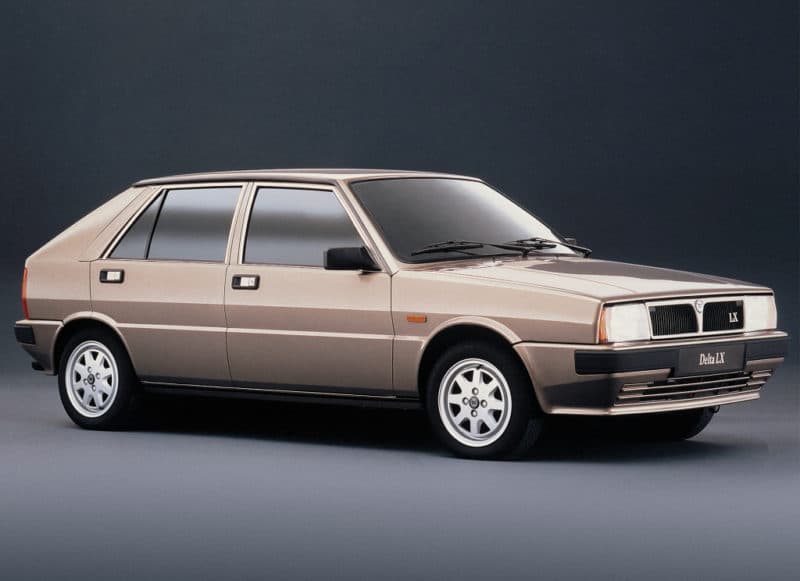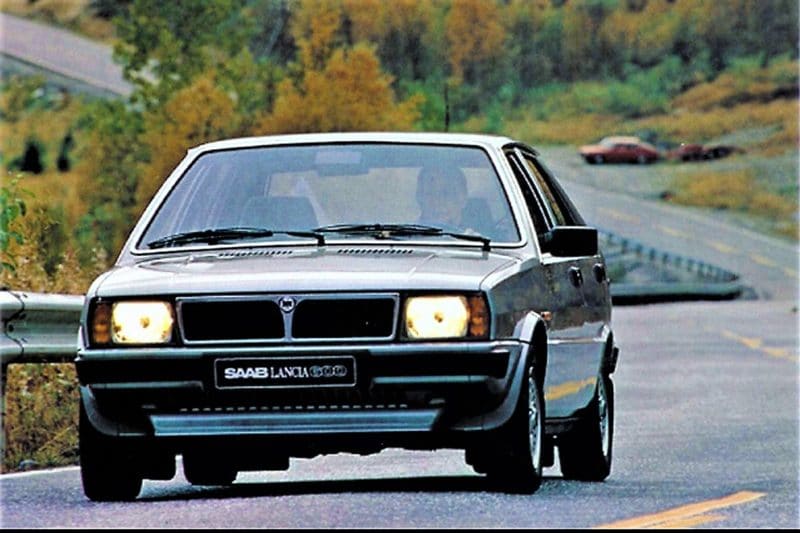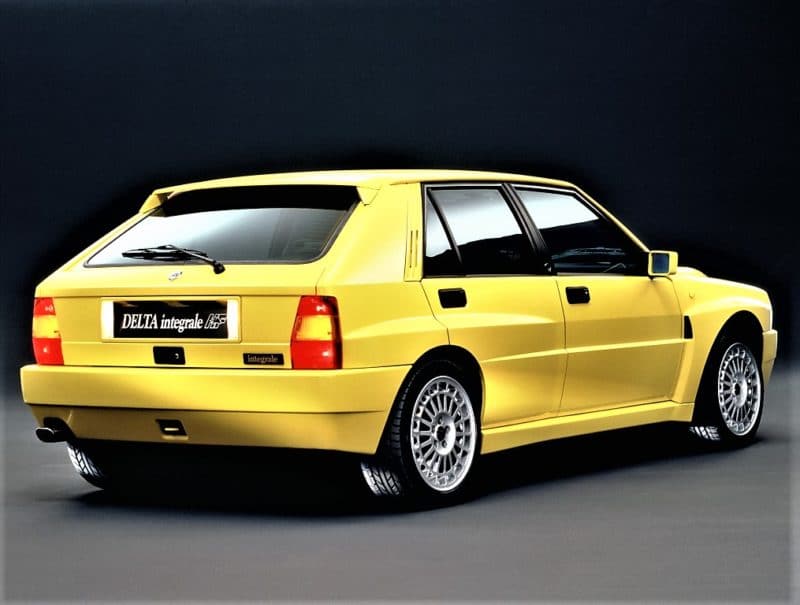In 1979 Lancia showed the new Delta to the public. The Lancia Delta was the result of project Y5, started in 1974 by Lancia's head of development, Sergio Camuffo. Giorgetto Giugiaro took care of the lines. In fact, the model with the distinctive corners became the first standalone premium model in the market that is now regarded as a C-segment, in which an increasing number of other manufacturers had already presented front-wheel drive compact hatchback models.
The Delta was the only Lancia in history to be named Car of the Year. He was allowed to carry the prestigious title in 1980. The compact Lancia hatchback won many more prizes. For example, from 1987 to 1992 Lancia won the World Rally Championship (WRC) constructors' title six times in a row with the Delta, and Lancia also won the drivers' title four times during this period. And that brought the total to ten world championships in six years. A major achievement.
Ritmo platform, different rear axle
Nobody dared to predict that during the presentation of the Lancia Delta in 1979. The Delta was primarily a luxury compact hatchback with an Italian coat. The technology originated in the basis of mother Fiat. Technically, Lancia used the Fiat Ritmo from 1978 for the first Delta. Both cars had front-wheel drive, but the family members differed from each other in terms of chassis. The RItmo had the transverse leaf spring at the rear. The Lancia Delta got an improved version of the Camuffo rear axle instead. In short: that was a combination of tie rods, stabilizer and independently sprung wheels, an application that was also used on other Lancia types from 1972.
Motorcycles and a Swedish Delta
Initially, SOHC Lampredi 1301 cc and 1498 cc engines were available for most markets. In those early years, the SAAB-Lancia 600 was also available for the Northern European countries, which had to fill in the gap for SAAB from 1980 due to the disappearance of the SAAB 96. Simply put, it was a Delta with a heating system equipped for the Scandinavian market. It was only available with the 1498 cc engine (85 hp) and was by no means a bargain. Today the Swedish Delta an absolute rarity, but also sales technically the SAAB-Lancia did not break any pots.
More and more powerful engines, and a small entry-level engine for Southern Europe
From November 1982 the Delta was also available with the 1585 cc engine, which Lancia installed in the GT version. In fact, this Lampredi DOHC engine laid the foundation for the rally successes of later. It started with the HF Turbo (with twin Weber carbs, Garrett T3 Turbocharger and intercooler), which generated 131 horsepower. From 1986 (the year that the Delta, among other things, received a new grille and interior changes) the 1.6 engines had injection. And later Lancia also applied the catalyst technology within the Delta family. In addition, Lancia also released the Delta with 1116 cc engine (known from the Fiat 128, among others) during that period, and this was specifically intended for a few markets in Southern Europe.
Breakthrough
Meanwhile, the Delta stood for the sporty breakthrough. At the end of 1986 the HF 4WD debuted with the 2 liter Lampredi Turbo engine from the Thema. At that time it was already clear that the perilous Group B rally was canceled by the FIA. That was the group in which Lancia was active with the four-wheel drive Delta S4 specially developed for rally purposes. Strangely enough, a fatal accident involving the S4 in Corsica (Henri Toivonen and co-driver Sergio Cresto lost their lives there) was one of the reasons for the FIA to remove Group B from the calendar. For certain markets, the S4 was also available as a street version: the Stradale. It was introduced in 1985 for homologation purposes and was built for three years.
Rally successes
Lancia, which had already made a name for itself in rallying with the Stratos and the 037, for example, developed a new asset for Group A. That was the HF Integrale, which appeared in the showrooms of Lancia dealers as a street gun in 1987 and which immediately took the global constructors and driver title in the Group A rally in the same year. Lancia became world champion in Group A another five times with the increasingly developed rally Deltas as a constructor. In 1992, however, mother Fiat abruptly pulled the plug on the rally adventures of the Italian noble brand,
Integral also as a street version increasingly beautiful and stronger
The HF Integrale was also refined and increasingly stronger as a street version from 1987 onwards. For example, there were double headlights, the wheel arches grew in width and the power grew to more than 200 hp. In addition, Lancia released special versions such as the Delta Martini 5 and 6, the Blu Lagos and the Bianca Perla. A Spider intended for Gianni Agnelli was also drawn on the basis of the Integrale. The pinnacle of the Lancia Delta a series however, was the HF Integrale Evoluzione II. Thanks to the necessary technical refinement (including modified engine electronics), this version became the fastest and the most powerful variant with 210 hp, if we derivative Do not count S4.
Turbo diesel and Hyena
On the economic side of the spectrum, the first Delta was also further developed, because a fine 1.9 Turbo diesel was added to the program. That continued through the 1994s. Zagato designed the Hyena on the basis of the HF Integrale. This coupé was created thanks to an idea of the Dutch restorer of classic cars and collector Paul VJ Koot. He liked a coupé version of the multiple World Rally Champion HF Integrale. This one came, and it was built in limited numbers for several years. In 1995 the first Delta generation officially retired, although until 173 a very last Italian series of XNUMX Integral copies were sold. That was the HF Integral Dealer's Collection, a series painted in beautiful burgundy red with things like brushed aluminum, a start button and a leather Recaro interior.
Few successful successors
Lancia built two more generations of the Delta. The Nuova Delta (1993-1999) and the taste-sensitive third generation of the Delta (2008-2014) were by no means a resounding sales success. The primordial Delta was. Not only was it built for more than fourteen years: Lancia also produced more than half a million of them. The Italians were successful in several respects with the Delta. And even legendary within rallying.



















Fantastic car!
Have had 2 Dedra's myself, in my opinion somewhat a Delta with ass.
The 1st was a 90er 1.8 ie Berlina with 80L lpg tank on the rear axle.
In the rain, start a 90 degree turn at 90 km/h.
Neutral drifting out, off the throttle, it threw the ass out in a controlled manner, making it look for the inside of the bend. Then full throttle to the outside again.
My passenger could barely keep the passenger seat dry.
A swerve at barely 200 km/h at Hoevelaken cost a few millimeters of rubber, but the car did exactly what I told her.
Later had a 95er Dedra 1.6 ie Sw and effortlessly driven to 350.000 km!
Unfortunately, due to a greatly reduced income, he had to leave the field and at the age of 17 he ended up at a Lancia-loving garage in Emmer-Compascuum.
Days go by when I don't miss them.....
Outside of Italy heavily underrated, trouble-free, very economical and comfortable cars.
Privately several and business (from the boss) many Germans and those things are maintenance-sensitive and expensive to maintain.
It's a shame that such a fantastic brand went under.... have had them all; economical quick coupler comfort; never regret 1 second! It's a pity that the German stuff is rampant; unity makes…
Dullness!
Every year the Delta Meeting is organized in Beesd. That's where the Lancia celebrates love.
Saab 600, the rarest and least sought after Saab in the series
Have you ever been allowed to drive the 2L street version with 200hp +. insane! Felt like some sort of 'gasoline powered catapult'. Beautiful car!
What a beautiful brand it is, with subtle details such as the grille with the logo.
stick a trunk on it, voila, the prism..